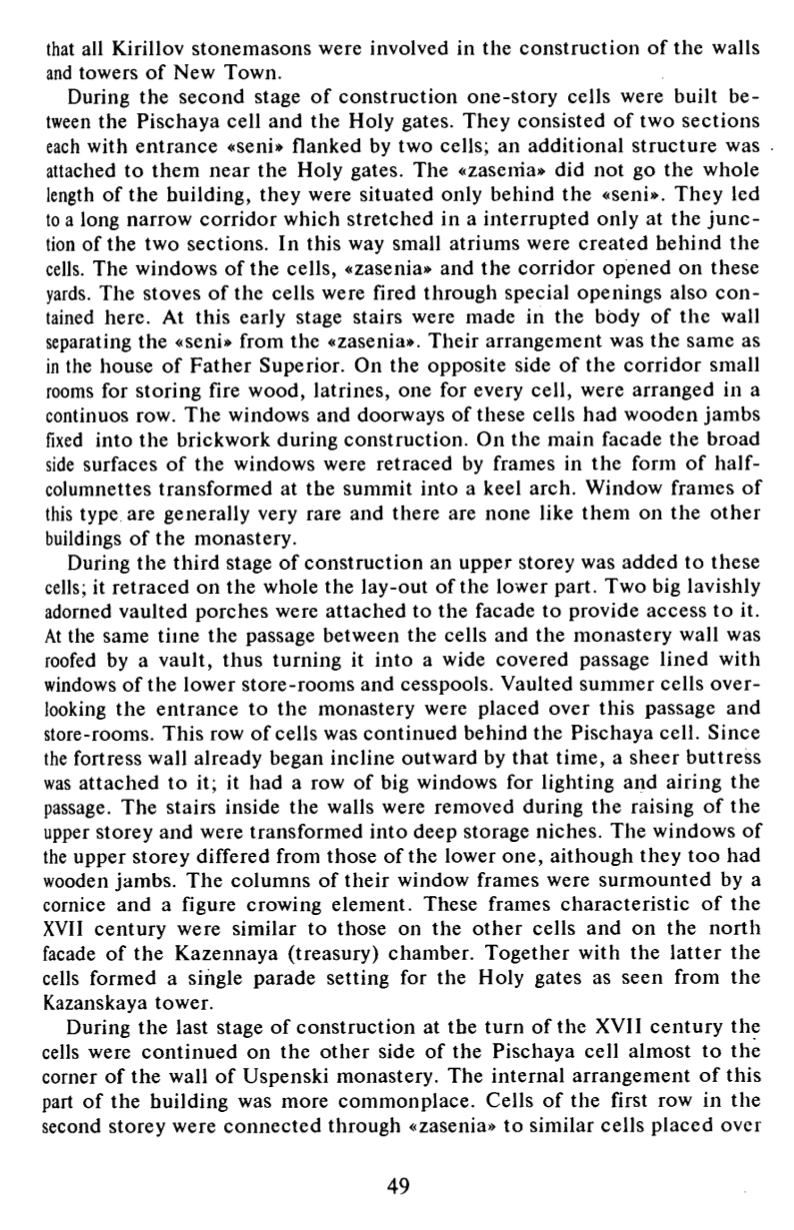

that all Kirillov stonemasons were involved in the construction o f the walls
and towers o f New Town.
During the second stage o f construction one-story cells were built b e
tween the Pischaya cell and the Holy gates. They consisted o f two sections
each with en trance «seni» flanked by two cells; an additional structure was
attached to them near the Holy gates. The «zasenia» did not go the whole
length of the building, they were situated only behind the «seni». They led
to a long narrow corridor which stretched in a in terrupted only at the j u n c
tion of the two sections. In this way small atriums were created heh ind the
cells. The windows of the cells, «zasenia» and the corridor opened on these
yards. The stoves o f the cells were fired through special openings also c o n
tained here. At this early stage stairs were made in the body o f the wall
separating the «seni» from the «zasenia». Their arrangement was the same as
in the house o f Father Superior. On the opposite side o f the corridor small
rooms for storing fire wood, latrines, one for every cell, were arranged in a
continuos row. The windows and doorways of these cells had wooden jambs
fixed into the brickwork during construction. On the main facade the broad
side surfaces o f the windows were retraced by frames in the form o f half-
columnettes transformed at the summit into a keel arch. Window frames o f
this type are generally very rare and there are none like them on the o ther
buildings o f the monastery.
During the th ird stage o f construction an upper storey was added to these
cells; it retraced on the whole the lay-out of the lower part. Two big lavishly
adorned vaulted porches were attached to the facade to provide access to it.
At the same time the passage between the cells and the monastery wall was
roofed by a vault, thus turning it into a wide covered passage lined with
windows o f the lower store-rooms and cesspools. Vaulted summer cells over
looking the en trance to the monastery were placed over this passage and
store-rooms. This row o f cells was continued behind the Pischaya cell. Since
the fortress wall already began incline outward by that time, a sheer buttress
was attached to it; it had a row of big windows for lighting and airing the
passage. The stairs inside the walls were removed during the raising o f the
upper storey and were transformed into deep storage niches. The windows of
the upper storey differed from those of the lower one, aithough they too had
wooden jambs. The columns of their window frames were surmoun ted by a
cornice and a figure crowing element. These frames characteristic o f the
XVII century were similar to those on the o ther cells and on the no rth
facade o f the Kazennaya (treasury) chamber. Together with the latte r the
cells formed a single parade setting for the Holy gates as seen from the
Kazanskaya tower.
During the last stage o f construction at the turn of the XVII cen tu ry the
cells were con tinued on the o ther side of the Pischaya cell almost to the
corner of the wall o f Uspenski monastery. The internal arrangement o f this
part o f the building was more commonplace. Cells o f the first row in the
second storey were connected through «zasenia» to similar cells placed over
49















